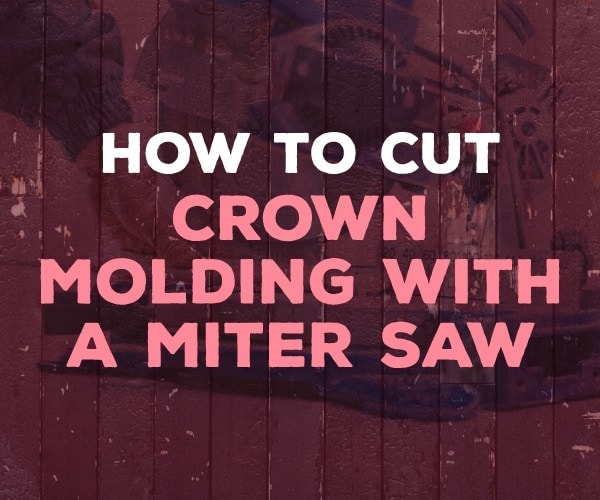A miter saw is often the best tool to use to cut crown molding.
Also known as cornice, crown molding is a decorative type of trim that stands out for its gracefully flared design.
But because of its flared design, crown molding is a little more difficult to cut than other types of trim, but it still can be done by just about anyone.
With the right tools (your miter saw) and a little knowledge (this guide), you will learn to accurately cut crown molding with ease.
Here’s exactly how to cut crown molding with a miter saw.
What You’ll Need
As the name of our guide implies, the best way to cut crown molding is with a miter saw.
Here’s what you’ll need:
- Miter Saw
- Tape Measure
- Carpenter’s Pencil
- Work Table
- Saw Horses
Step I: Measure and Mark
Like most cutting projects, this one starts with making accurate measurements.
Use your tape measure to accurately measure the length of the wall where each piece of crown molding will go.
Remember that accuracy is of paramount importance for this particular project. Even a mistake of just 1/16 inch will cause major problems.
With that in mind, don’t just measure once. Measure twice, or even three times, to double or triple check your work for accuracy.
Once you have accurate measurements, mark down the cut line onto each piece of crown molding with your carpenter’s pencil.
Consider making each cut slightly longer, say 1/18 to 1/16 of an inch, than it needs to be.
Then fit the pieces together. Continue to snip the extra length off each piece until all the pieces fit together tightly. This will help prevent errors that could potentially render a length of your crown molding useless.
Step II: Make the Cut
Here comes the tricky part: making the cut.
Because you want the two pieces of crown molding to come together seamlessly in a corner, you’ll likely have to make angled cuts on each end.
These cuts should be made so that the two pieces of crown molding fit together flush and smooth.
Fortunately, most homes have roughly 90 angles in the corners, meaning that each piece must be cut at a 45 angle. These cuts will ensure that the ends of the pieces are each 45-degree angles, coming together to form a 90-degree angle.
Your miter saw should have an adjustable blade or swiveling head so that you can line up cuts at this angle.
Before making each cut, ensure that the piece of crown molding is turned on its back side. You want to cut from back to front to minimize the risk of damage from the teeth of the blade.
Press each piece of crown molding flush with the fence of the miter saw.
For long pieces, it’s very helpful to have a friend help hold the end of the pieces. Alternatively, you can fashion a support from sawhorses.
Make each cut by running the blade slowly and gently into the crown molding on your cut line.
Step III: Join and Scab
Joining two pieces of crown molding together in a corner is tricky in itself.
It requires angled cuts and accurate measurements. As mentioned above, the best bet is often to make the cuts slightly longer than needed. Then shave off little bits until everything fits perfectly.
Another common situation that arises during this project is the need for a longer straight piece of crown molding than is available.
In other words, one single wall of your home is so long that you must join two pieces of crown molding to stretch the entire thing.
The intuitive method might be to simply attach two pieces of crown molding together with their flat ends touching.
Unfortunately, this method, while easy, will result in shoddy and unprofessional looking craftsmanship.
You’re much better off making an angled cut on each of the two pieces so that they fit slightly over top each other for a flush look once installed.
Known as scabbing crown molding, adjust the blade to make a 22.5-degree cut at the ends of each piece so that they fit cleanly together in a 45-degree angle.
Final Thoughts
It might seem intimidating to cut crown molding if you’ve never done it before.
In reality, the project really isn’t that hard with the right miter saw and the wherewithal to double check all of your measurements.
Do both of these things, and I’m sure that with the help of this guide you’ll be more than capable of cutting and installing crown molding with zero issues.
Once you’re finished with this project, we’ve compiled some great DIY ideas for projects you can take on next!
Enter your text here...

